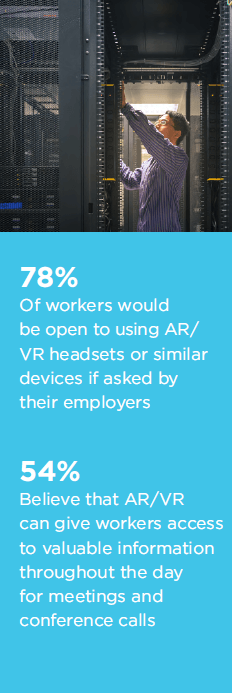When many of us think of XR technology, we think of its entertainment applications. However, a number of industries are also increasingly using it. But, how do people feel about that? According to a recent study by a tech group Mojo Vision, people feel pretty good about it.
What Did Respondents Say?
Mojo’s focus is on the future of technology. However, the survey, in which 1,000 employed Americans between the ages of 18 and 65 participated, also addressed attitudes towards XR technology today. According to the report titled “Tomorrow’s Workplace Technology – What Happens When Things Get Personal”, released this morning, 78% of workers would be open to using VR/AR headsets at work. And 25% said that they already have.
Interested in the future, Mojo also addressed how people see the future of these technologies in the workplace. Fifty-six percent of workers said that future technology would be beneficial to their jobs. According to their beliefs, AR/VR can make it “easier to communicate with people in other locations or in different languages” (54%), as well as give workers access to valuable information for meetings and conference calls (56%). The majority (55%) also believes that someday AR and VR headsets will be just as common as smartphones are today. Another 42% said that wearable devices will replace conventional screens within ten years.
Why They Said It?
So, why were respondents so enthusiastic about XR technology? According to the report, respondents said that future technology would help them to recall critical information, maintain focus on people or projects while recalling data, increase productivity, and even speak in public with more confidence.
And why aren’t we all using this technology now? Well, some respondents still have some concerns. While 47% said that AR would allow them to maintain face-to-face interactions, a statistically similar 42% said that AR would get in the way of these interactions. This sort of stigma was shared by a further 49% who said that they would feel “uncomfortable” wearing a headset around colleagues. Almost half (49%) of respondents also said that they were concerned that wearing a headset for extended periods of time would be uncomfortable. A further 51% said that they were concerned about privacy issues.
 Privacy issues are a particularly pressing concern in the case of AR technology. While VR technology allows you to occupy your own little world, AR often requires the use of a camera device.
Privacy issues are a particularly pressing concern in the case of AR technology. While VR technology allows you to occupy your own little world, AR often requires the use of a camera device.
The Future of XR Technology?
The report didn’t just include the results of the survey. It also includes some trends that Mojo sees in XR technology. They summarise these trends as “the decline of the smartphone” and “the rise of AR/VR.”
“The decline of the smartphone” is writing that you may have seen on a few walls, even if the letters are bigger than they need to be. This is the first year that smartphone sales have declined. They’re expected to be down 3.2% from last year.
“For years, these devices have been intertwined with our personal and professional lives, providing access to critical information when we need it the most,” reads the report. “But as history has shown with Palm Pilots and Blackberries, today’s smartphones can also be seen as a stepping stone to the development of something far greater.”
No market is limitless and you don’t realistically need to start worrying about what will replace your smartphone. However, Mojo has an answer: it’s XR technology.
“Looking toward the next wave of technology, commercial enterprises are indicating that AR/VR adoption in the workplace is not a matter of if, but when,” says the report. “IDC predicts that commercial sectors will account for 80 percent of worldwide spending on AR/VR products and services by 2022.”
That makes it sound like casual XR technology users are being shoved out of the market. Don’t worry, that’s not the case. Industry applications of XR technology are typically far more expensive than casual applications. That means that industry can drive the market while leaving room for the rest of us.
Further, at the moment, nearly all AR technology and much VR technology relies on smartphones. As a result, the report may stress competition or dichotomy between smartphones and XR technology that isn’t necessarily there.
The Takeaway
Mojo Vision’s report made some pretty big claims. Some of them sound exciting, others almost frightening. You can take them for what they’re worth but remember that no prediction is guaranteed.




